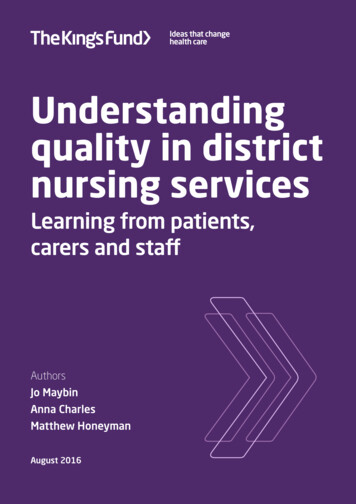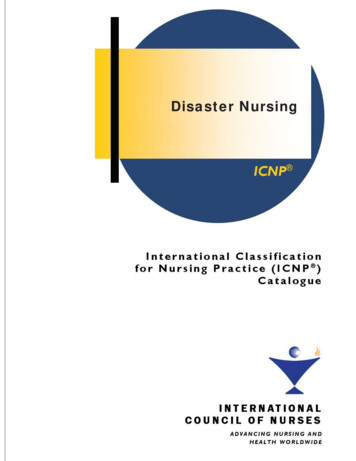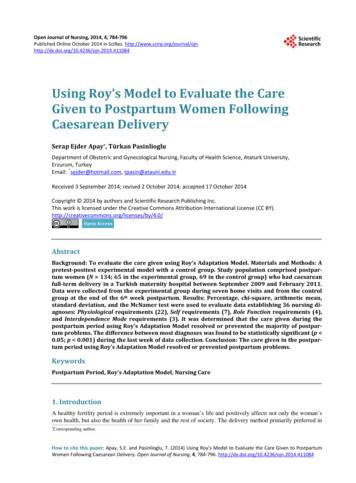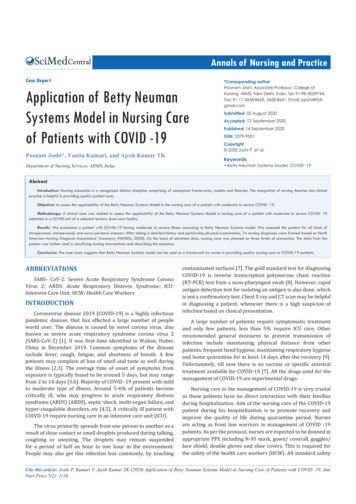
Transcription
Outstanding Models of District NursingA joint project identifying what makes an outstandingDistrict Nursing Service.Outstanding Models of District Nursing - 1
ContentsForeword 3Executive Summary 4Recommendations 5Context 7Introduction to the project 11Project methodology 11Project findings13Reflection and summary36Author: Dr Agnes Fanning, District Nurse and Queen’s NurseCopyright The RCN / The QNI 20192 - Outstanding Models of District Nursing
ForewordThe District Nursing service delivers high quality care to individuals in the home environmentand supports carers, families and communities everywhere. In 2018 the Royal College ofNursing (RCN) and the Queen’s Nursing Institute (QNI) became increasingly aware of the needto articulate the value of the District Nursing service in England and to describe the elementswhich make up an outstanding model of care.Policy documents consistently refer to the need for more nursing care to be delivered in thecommunity and people’s homes, to reduce lengths of stay in hospital and avoid unplannedadmissions, for more people to experience end of life care at home and for those with multiplecomplex long term conditions to be supported expertly in the community. But these policieshave not been followed up by an exposition of what the District Nursing service would need tolook like in order to support this vision; nor have they been informed by patients who receivecare from those providing these services. We have been concerned that some policy initiativesmay have the effect of making the role of the District Nurse appear obsolete, without anymeaningful consultation with the profession and the people receiving the service.The RCN and the QNI therefore took the opportunity to partner in creating a ‘360 degree’ viewof the District Nursing service and the elements which need to be in place to enable excellencein its delivery. A considered and thoughtful project plan was developed and a yearlong projectensued, including a review of the evidence, wide consultation, testing of the model andconfirmation by multiple stakeholders.We are delighted with this first joint publication by our two national organisations, not leastbecause the users of the District Nursing service and their carers have a central voice in thereport and provided the ‘touchstone’ throughout the year of the project. No conversation tookplace without placing the patient at the centre of the discussion and considering the implicationsfor the person receiving the service and their families and carers. Our desire now is to ensurethat the findings of this project are tested with patients.Chapter One of the NHS Long Term Plan in England states that: ‘Now expanded communityhealth teams will be required under new national standards to provide fast support to peoplein their own homes as an alternative to hospitalisation, and to ramp up NHS support for peopleliving in care homes’. This is the role of the District Nursing service, delivered everywherein England within a variety of models and under varying contracts. This service and thecomprehensive approach it takes to delivering care to patients must be acknowledged andvalued. We are concerned that any remodelling or dissolution of this service to a task basedapproach carries with it great risks to the care of patients in England.This report by the RCN and the QNI presents a blueprint for the District Nursing service,supporting the aspiration of the Long Term Plan and recognising that there are many exemplarservices already operating very successfully and which could be replicated throughout England.Our sincere thanks to all stakeholders who have contributed to the review and gave sogenerously of their time and expertise. We are indebted to you for your insight and clarityinto the challenges faced by this highly complex area of nursing – and one which is poised toprovide the solutions which are needed right now in every community in England.We look forward to working with the Department of Health and Social Care in the comingmonths to implement the recommendations of this report.Dame Donna KinnairChief Executive, The RCNDr Crystal Oldman CBEChief Executive, The QNIOutstanding Models of District Nursing - 3
Executive SummaryProject AimsThis is a joint project between The Royal College of Nursing (RCN) and The Queen’s NursingInstitute (QNI).The aim of the project is to analyse the District Nursing (DN) service and identify what makesan outstanding District Nursing service which: Meets the needs of patients, families and carers;Supports and benefits the wider health and social care system through integrated caredelivery;Acknowledges all the elements that are required to be in place at a system and anoperational level nationally, regionally and locally to prepare, support and maintain asustainable District Nursing service.The project involves an exploration of a variety of District Nursing service models and the viewsand experiences of a wide range of stakeholders.This report makes a number of recommendations, responding to the findings of the project.Note on Terms UsedTerms and words used in relation to community services may be interpreted differently bypeople, therefore key words and terms used have been defined in the context of this studywithin Appendix A. For ease of reference, these are: OutstandingDistrict Nurse (DN)Community NurseQueen’s Nurse (QN)District Nursing teamClinical Commissioning Groups (CCG)Higher Education Institutions (HEI)Continuing Professional Development (CPD)The Role of the District Nursing ServiceTo meet the needs of patients, families and carers, District Nurses lead and support their teamsto deliver care in a variety of community settings (Department of Health, 2013). Many DistrictNurse teams work in a central location, sharing office space with community teams from nearbygeographical areas. This gives an opportunity for teams to share best practice and to gainpeer support from each other. However, this also may result in District Nurses and their teamsvisiting patients across geographical areas, leading to lack of consistency in the named nurseor team providing the visits to patients and their families. This has the potential to impactnegatively on patient outcomes and patient satisfaction (Russell et al, 2011).The District Nursing service is typically commissioned by the clinical commissioning group(CCG) as part of a community services contract. It provides nursing services to people in theirown homes and communities within a local population, defined by a geographical location ora GP registered list (NHS Improvement, 2018). District Nurses play a crucial role in caring forpatients, who often have complex care needs, in their own home and in the wider communitysetting where frequently the care environment adds to the complexity (NHSI, 2018).Workforce ChallengesIt is estimated that in 2018 there were only approximately 4,000 District Nurses (NHSEngland, 2017) to provide care to a population of approximately 55.8 million in England alone4 - Outstanding Models of District Nursing
(ukpopulation, 2017). Unfortunately, due to a 46% decline in the number of qualified DistrictNurses since 2010 (NHS, 2018) many community nursing teams have become ‘task focused’(Malbin et al, 2016) thus reducing their capacity to exercise a population health approach tocare.The NHS is currently suffering the worst ever staff crisis with a shortage of 41,722 nurses inEngland which is 11.8% of its entire nursing workforce (Campbell, 2018). This is compoundedby the fact that the number of nurses and midwives leaving the profession in 2017 has risenby 51% since 2013, with 20% more people leaving the Nursing and Midwifery Council registerthan joining the profession in the years 2016/2017 (NMC, 2018). The average age of nursesleaving the register has also gone from 55 years in 2013 to 51 years in 2017 and 2,901 leaverswere between the ages of 21 – 30 (Siddique, 2017).These figures not only impact on the hospital nursing workforce, but also on the District Nursingworkforce. Media reports frequently focus on hospital services and accident and emergencyservices, yet there is little acknowledgement that the number of patients being seen in hospitalwould be far higher if there had not been intervention by the District Nursing service preventingmany hospital admissions.As it stands, 2017/2018 witnessed a rise of 9% in accident and emergency admissions since2011/2012, reaching a total of 15.4 million accident and emergency attendances accordingto the State of Care 2017/2018 Report (Care Quality Commission, 2018). Clearly this figureis in part dependent on the capacity and the capability of the District Nursing services in thecommunity being able to prevent unplanned admissions and support people to be safely caredfor at home.RecommendationsIn meeting the needs of patients, families and carers in the community, the key recommendationsof this project are: To create a workforce fit for purpose it is essential that District Nurses continue togain a post qualifying District Nurse Specialist Practice Qualification (DNSPQ) whichdevelops their personal and professional growth and enhances their clinical skills to leadand educate teams, patients and families, promoting autonomy and independence andconsequently having a greater impact on the delivery of high quality care and improvedpatient outcomes. To develop a strategy which will expand commissioners’, providers’ and the public’sunderstanding and knowledge of the District Nurse role, enabling them to criticallyanalyse the current role and recognise the added value they bring to the economy andparticularly to the wider Health and Social Care system where they are central to the futuregrowth in modern, integrated health care. To promote the population health element of the District Nurse role. Whilst this isfrequently opportunistic it plays a crucial role in personalising care, promoting the preventionof ill health, changing the patient’s lifestyle to benefit their well-being. To develop a national standardised data collection system and data set withinEngland, collecting meaningful data that recognises ‘value for money’ and is not just seenas a ‘notional saving’, thus promoting a strong economic case for investment in the DistrictNursing service and providing systems at an operational level nationally, regionally andlocally to prepare, support and maintain a sustainable District Nursing service.Outstanding Models of District Nursing - 5
‘There has been a 46% reduction in qualified District Nurses in theUK since 2010.’BBC Report 20176 - Outstanding Models of District Nursing
To develop a national standardised approach to the assessment of quality in order tomeasure the effectiveness of the District Nursing service in England, providing structuredmethods and reliable data, enabling innovation and cost-effective practice to be captured,recognised and disseminated. To support safe staffing and safe caseloads to ensure that the principles of safe staffingin the community meet the RCN (2017), QNI (2018) and NHSI (2018) recommendations forsafe staffing and safe caseloads. To actively explore the co-location of District Nursing teams within Primary CareNetworks to provide personalised care, continuity of care and enhanced workingrelationships across primary and community care teams.ContextA. Delivering Care Closer to HomeDistrict Nursing has progressed greatly since the first District Nurse training in Liverpoolcommenced in 1863. At that time District Nursing was viewed as an essential and crucial rolein nursing patients in their own homes and preventing hospital admissions. The District Nursingservice has been core to the NHS since its inception and continues to play an important role inthe delivery of community health care to local populations.When District Nursing first commenced, the focus was to care for ill patients at home, butthey also had a very prominent public health role in considering the psychosocial impacts thataffected the health of their patients. As years have gone by, the care of patients in their ownhomes has become more complex, with many patients requiring high technical assistance toenable them to stay in their own homes. As an autonomous practitioner the District Nurserequires an evidence-based approach to care enabling patients to remain at home and preventhospital admission. This involves providing additional education and training to assist them todeliver ongoing safe, effective care to patients at home. Although people are living longer thisfrequently means that they are living with more long-term conditions and health and care needs.With the focus of care being delivered closer to home and with many District Nurses deliveringa 24/7 service, there is arguably a need for more qualified District Nurses (DNSPQ) to be inpositions of leading teams of community nurses. A small number of providers across Englandhave introduced neighbourhood nursing models based on small self-managing teams ofcommunity nurses who spend at least 60% of their time with patients (Merrifield, 2018). This hasseen providers recruiting newly qualified nurses who are inexperienced in community nursing.The philosophy of team working is positive but working in the community can be isolating anddecisions need to be made promptly, frequently without the support of other health professionalsbeing in the home at the time of decision making; the question of sustainability therefore arises.NHS Providers (2018) recognise this, saying that ‘considerable attention needs to be given toup-skilling staff and supporting them to adapt how they are working’.The King’s Fund report (Malbin et al, 2016) acknowledged that good care is being compromiseddue to increases in the number of patients requiring complex patient care. These concernscannot be ignored as the demographics in England change. For example, a provider in theSouth East of England serves a population of approximately 534,000 with a 39% expectedincrease of 65-year olds and older by 2030, and in larger providers with higher populationdensity these increases may be greater. One such example is a provider in the North of Englandwhich serves a population of 800,000 with approximately 2,100 hospital beds. The number ofOutstanding Models of District Nursing - 7
patients (‘beds’) on the District Nursing caseload at any one time, regardless of the number oftimes a week (or day) the patients are seen, is approximately 6,744. Inevitably the changingpopulation profile will add more pressure on community and District Nursing services.B. Nursing Workforce ChallengesThe NHS is currently suffering the worst ever staffing crisis with a shortage of 41,722 nurses inEngland, which is 11.8% of its entire nursing workforce (Campbell, 2018). This is compoundedby the fact that the number of nurses and midwives leaving the profession in 2017 has risenby 51% since 2013, with 20% more people leaving the Nursing and Midwifery Council registerthan joining the profession in the years 2016/2017 (NMC, 2018). The average age of nursesleaving the register has also dropped from 55 years in 2013 to 51 years in 2017 and 2,901leavers were between the ages of 21 – 30 (Siddique, 2017).These figures not only impact on the hospital nursing workforce, but also on the District Nursingworkforce. Media reports frequently focus on hospital services and accident and emergencyservices, yet there is little acknowledgement that the number of patients being seen in hospitalwould be far higher if there had not been District Nurse intervention preventing many hospitaladmissions. As it stands, 2017/2018 witnessed a rise of 9% in accident and emergencyadmissions since 2011/2012, reaching a total of 15.4 million accident and emergencyattendances according to the State of Care 2017/2018 Report (CQC, 2018). Clearly this figureis in part dependent on the capacity and the capability of the District Nursing services in thecommunity being able to prevent unplanned admissions and support people to be safely caredfor at home.Concerns about the declining numbers of District Nurses have been voiced for many years witha BBC Report (2017) claiming that there has been a 46% reduction in qualified District Nursesin the UK since 2010 (Figure 1). The RCN (2014) expressed their concern regarding theDistrict Nursing workforce, reporting there has been a 47% drop of District Nurses in Englandalone suggesting they ‘will face extinction by 2025’ if the number of District Nurses does notincrease to meet the growing demand to provide high-quality care. NHS Digital (2018) alsoreinforced these views claiming that District Nurse education commissions in England hadfallen by a further 0.8% from 2015/2016 to 2016/2017.The reduction in the number of District Nurses in recent years has implications, as evidencedin a report published by independent research body Christie & Co (2017), revealing that theysaw an increase in the older population being admitted to hospital, claiming that the key factoris the reduction in District and Community Nurses at a time when hospitals are already dealingwith capacity challenges. This report acknowledges that the District Nurse plays an essentialrole in preventative care, thus reducing hospital admissions.Figure 1.Declining number of District Nurses in England since 2010.8 - Outstanding Models of District Nursing
Consideration must also be given to safe staffing and safe caseloads in the District Nursingservice which the QNI (2016), RCN (2018) and NHS Improvement (2018) have all reported.Yet interviews undertaken with District Nurses as part of this project have shown that staff arecontinuing to work to full capacity, working beyond their allocated duty hours and frequentlyworking through the day without a break. However, where an appropriate staff/patient ratio wasevident, District Nurses have been able to carry out outstanding quality care. There are a varietyof caseload management tools available which aim to minimise waste, improve productivityand provide evidence of the effectiveness of the District Nursing service (Roberson, 2016),enabling them to prioritise care and allocate accordingly the right nurse with the right skills.C. National PolicyThe most recent government policy which will impact on the District Nursing service in Englandis the NHS Long Term Plan (NHS, 2019), stating that there will be increased funding for primaryand community care of at least 4.5billion to support approximately 90% of the one-millionplus patient contacts that the NHS achieves every day in primary and community care settings(QNI, 2019). Prior to this there had been an inconsistent priority in the distribution of fundsacross NHS services so it seems that this longstanding underfunding for community serviceshas now been recognised. What is not clear is how this 4.5billion will be divided, as one ofthe key barriers in seamless primary and community care is the different funding streams forhealth (primary/community) and social care. Where there is evidence of joint funding betweenhealth and social care, as seen in some of the early Vanguard sites (new care models), it hasbroken down many of the financial barriers that interrupt seamless care from happening. Thisis particularly evident in the multispecialty community providers of new care models whereprovision of integrated community care has been implemented.‘The Five Year Forward View’ (NHS, 2014) has been instrumental in these transformationsoccurring within community services across England. There has been an increase in integratedservices and social enterprises acknowledging that ‘one size does not fit all’ (NHS, 2014)offering local clinical commissioning groups more control over the services they commission.Where the District Nursing service has been commissioned there is evidence to show thatpatient outcomes are improved and there is better partnership working, particularly with theGPs. One such example is in the South East of England where, with the assistance of theCCG, community provider and a local alliance of GP practices, District Nurse numbers wereincreased and efficiency through reablement of patients was realised (Chilvers, 2018).The Long Term Plan (NHS, 2019) provides a renewed focus on supporting people in thecommunity and on illness prevention, giving District Nurses the opportunity to play a key rolein leading teams, working together with other health and social care professionals, to providecare to the most vulnerable people of our society, many of whom will have complex long termconditions such as respiratory disease, cardiovascular disease, diabetes, cancer, neurologicaland many other conditions. Charles (2019) suggest that this will require increasing the capacityof teams so that crisis response services can meet response times set out in guidelines by theNational Institute for Health and Care Excellence (NICE). Additional team capacity will providethe District Nurse teams with greater opportunities to provide the right skills and right nurse fortheir patients. Currently, because of a lack of investment in the District Nursing service this isnot always possible, due to the task focussed way that District Nurses have been compelledto work.To prevent care being compromised, and to achieve the ambitions of policy change and respondto changing models of care delivery, it is essential that there is greater investment in the DistrictNursing service.Outstanding Models of District Nursing - 9
‘The District Nurse is the backbone of community healthcareservices.’10 - Outstanding Models of District Nursing
Introduction to the projectThis project focuses on England only as other areas of the United Kingdom have already givensignificant attention to the District Nursing workforce. Wales reviewed their District Nursingworkforce in 2014 and as a result of their findings the Welsh Audit Office (2017) developeda checklist to support NHS Board Members to seek assurance on how local District Nursingresources are managed. Scotland continues to deliver the Scottish Government’s 2020 Visionthrough providing highly skilled clinical care at home and in order to do this has developed aDistrict Nurse Continuing Professional Development (CPD) learning resource based around the‘Pillars of Practice’ model to support District Nurses’ ongoing professional development (NHS,2018). Northern Ireland has developed ‘A District Nursing Framework 2018-2026 (2018)’.The overall aim of this project is to provide an evidence-based exposition of outstanding modelsof the District Nursing service that: Meets the needs of patients, families and carers;Uses an integrated approach to care that supports and benefits the wider health and socialcare system;Acknowledges all the elements that are required to be in place at a system and an operationallevel nationally, regionally and locally to prepare, support and maintain a sustainable DistrictNursing service.Project methodologyThe project was informed by views of a range of stakeholders and drew on the political andprofessional literature and contexts to support findings and discussions. These perspectivesbrought together a breadth of knowledge and expertise from voices of the different participantgroups. To attain a clearer perception into the current situation across England a mixedmethodology approach was used.Due to the diversity of participants a variety of research methods were chosen as listed below: Online digital questionnaire Focus groups Interviews Workshop discussions Hard copy questionnaires TestimonialsThe questions below were used to frame the engagement activities and meet the outcomes ofthe project: How is an outstanding District Nursing service recognised? How is this being measured? What personal attributes and skill set are required to lead a successful District Nursingservice? What added value does the District Nurse Specialist Practice Qualification (DNSPQ) bringto the service? How is this evident? Is the District Nurse service adequately resourced to meet the needs of the local population?Outstanding Models of District Nursing - 11
What mechanisms are in place to support the District Nursing service?Is the District Nursing service sustainable?What are the perceived threats to the District Nursing service?Where there were large groups such as General Practitioners (GPs) and District Nurses (DN) adigital online questionnaire was developed. This had the potential for a speedy response whilstmaintaining anonymity and was easily distributed across the geographical areas in England. Italso provided both qualitative and quantitative data.Professional meetings, such as the QNI Community Nurse Executive Network (CNEN) and theNational District Nurse Network (NDNN) provided an opportunity for workshop discussions anddissemination of hard copy questionnaires. Focus groups and interviews enabled flexibility forthose who had been unable to attend workshops or who were too widely dispersed but werekeen to participate in this project.Patient testimonials, carer testimonials and manager testimonials were also accessed throughthe QNI database. All responses were anonymous with no specific employer, individual nurse,educator, patient or carer identified.24 executive nurses from clinical commissioning groups participated in a workshop discussionand a further 7 completed a hard copy questionnaire which replicated the questions basedaround the workshop discussion.An online digital questionnaire was sent to General Practitioners (GPs) via the British MedicalAssociation General Practitioner Committee (BMA GPC). The digital questionnaire link wassent to 125 local medical committees (LMCs) and this was disseminated via a newsletter toall GPs that LMCs have contact details for. According to NHS statistics (NHS, 2019) thereare 38,383 qualified GPs in the UK and it is impossible to identify how many GPs read thenewsletter, however 110 responses were received from GPs. An online digital questionnairewas also sent out to 1,184 District Nurses who had been awarded the title ‘Queen’s Nurse’ and285 responded.40 clinical leads/managers participated in a workshop discussion. Additionally, a further 3focus groups (3 in each focus group) took place, 4 manager testimonials were received and 5individual interviews were carried out with clinical leads.104 patient testimonials were analysed, 8 carers were interviewed, and 5 professionalorganisations were involved in either a discussion group (2) or individual interviews (3).The visual diagram (Figure 2) demonstrates the wide ranging number of stakeholder participantsinvolved in this project. Appendix B gives a more detailed account of the representation ofindividual organisations involved.12 - Outstanding Models of District Nursing
Project FindingsFigure 2.Stakeholders involved in the anagersDistrictNursesDN onalOrganisationsPatientsCarersGPsA. Care Quality Commission ReviewsThe project commenced with an examination of the outstanding reviews from the Care QualityCommission (CQC) reports for adult community health services and a meeting with theCQC Lead for Primary Care. It was anticipated that this would give insight into how the CQCdifferentiated between the various services that delivered adult community care. However,this proved to be more challenging than originally anticipated. It became evident that a DistrictNursing service is not reviewed as a single independent service. Instead, this service straddlesseveral other services which form part of the assessment, such as health and social care, carehomes, long term conditions, end of life care and mental health services. This reflects theimplementation of the Transforming Community Services (TCS) programme (DH, 2008) andthe Health and Social Care Act (2012) where numerous structural changes within communityservices have taken place, resulting in poorly understood community services and confusionin commissioning of services in some areas. However, the introduction of the NHS Long TermPlan (2019) will potentially see District Nurses leading a variety of community services, whichmay prevent District Nursing services being reviewed separately.Community health services are complex in terms of how they are delivered, who providesthem and who pays for them. Due to the numerous organisational changes resulting fromthe Transformation of Community Services it is difficult to identify the stand-alone communityproviders who are responsible for exclusively delivering community services in one specificarea. However, the NHS, statistics, facts and figures report (2017) recognises that there are 35community stand-alone community providers in England (Figure 3).Outstanding Models of District Nursing - 13
‘The GPs’ view is that the District Nursing service averts crisesand provides excellence in social prescribing and recognisingconditions such as social isolation.’14 - Outstanding Models of District Nursing
Figure 3.Stand-alone Community ProvidersIn England Only35 CommunityProviders11 NHS Trusts6 FoundationTrusts17 SocialEnterprises1 LimitedCompanyNHS statistics, facts and figures report (2017)There are many other community providers which form part of an acute hospital trust or amental health trust and as the Care Quality Commission reports were reviewed it becameapparent that Outstanding service was not applied across the service but only applied tospecific areas of service delivery, such as being responsive and caring. No single CQC reportidentified outstanding in all the five areas: safety, effective, caring, responsive and well-led.Positive overall reviews resulted from findings of a well-led service and where care was deemedsafe and effective. Additionally, where a positive, open and transparent culture was apparent,wher
Nursing (RCN) and the Queen's Nursing Institute (QNI) became increasingly aware of the need to articulate the value of the District Nursing service in England and to describe the elements which make up an outstanding model of care. Policy documents consistently refer to the need for more nursing care to be delivered in the










